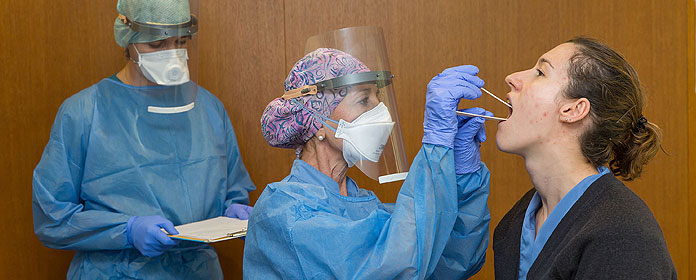2020_06_04_noticia-primeras-pcr
The University initiates PCR testing of its staff
Dr. Fernández Montero: "With preventive and diagnostic tools and therapeutic advances, we can maintain an active society and control Covid-19 until the possible arrival of the vaccine".

The University of Navarra has begun this week to carry out PCR tests on 500 employees from Cima and other centers and services. From the last week of August, the second phase of this process will be carried out with PCR tests to the rest of the employees and students of the academic center. More than 40 professionals from the biosanitary field of the University of Navarra will work on the performance and analysis of about a thousand tests per day, coinciding with the beginning of the academic year.
The first PCR tests are being carried out on those employees who, due to the characteristics of their position, have been working in a face-to-face manner since April 20. Other risk factors have also been taken into account, such as having been at contact with an infected person, having diabetes, hypertension or a lung disease; immunosuppression or being under cancer treatment; being over 60 years of age or being pregnant. During the next few days, about 130 tests will be performed daily. In a 24-hour deadline will be communicated if the test is positive and the consequent safety and prevention measures to be taken.
PCR testing is part of the plan designed by the University of Navarra to deal with the consequences of Covid19. One of the main axes of this plan is precisely to guarantee a safe campus and to ensure the health of all its employees and students at all times.
Dr. Alejandro Fernández Montero, of the University of Navarra's Health & Safety Office - area COVID-19 Joint Service, points out that the performance of all these tests will make it possible to obtain data of how the epidemiologicalstatus is at an important time such as the beginning of the academic year at the University. "PCR provides a 'diagnostic picture' in a population screening. It is important to know the starting point, but as long as the disappearance of the disease cannot be ruled out, it will be convenient to study the possibility of random PCR sampling of a representative sample of the population to avoid a new disaster of similar magnitude to what we have gone through", he assures.
The physician indicates that a university is not in itself a community with a higher risk of contagion than others, although he warns that the transmission of the virus is favored by open population groups, those who come from different places; and with greater socialization, hence the importance of testing among the student community. "If we are prepared and act at the first signs of the risk of a resurgence we could live with the disease. This is neither supposition nor science fiction. There are countries that have done so at times when the behavior of the disease was less known. With the epidemiological, preventive and diagnostic tools, and with therapeutic advances, it is possible to maintain an active society with satisfactory control of COVID-19 disease until the arrival of a possible vaccine," he continues.
Advantages of the test PCRDr. Alejandro Fernández Montero explains what information this test provides: "PCRs detect RNA material of the virus. The sample is collected with a pharyngeal swab and analyzed at laboratory. It is the test that tests positive the earliest. This allows, in addition to a rapid diagnosis of the disease, the application of isolation measures to prevent the patient from infecting others and the search for close contacts to stop the spread of the disease. It provides data to decide when it is appropriate to break the isolation of an affected person and can also be carried out massively among the population. Almost all the countries that have managed to keep their Economics open while controlling the epidemic had in common the performance of massive PCR tests for the prompt isolation of patients and their close contacts", he adds.
Alejandro Fernández Montero provides some information on the progress of the disease in Spain at data : since May 16, less than 500 new cases per day have been diagnosed by PCR in Spain, which means that there are less than 11 cases/day per million inhabitants. In addition, the instantaneous basic reproductive issue , i.e. the average number of cases that each infected subject is infected with, has remained below 1 since April 3. "These data are good news because they indicate that the pandemic is being controlled in our country, although we cannot say that COVID-19 will certainly disappear in our environment. We have examples of viruses that in similar progressions have disappeared completely, others that have resprouted again and others that remain circulating in a residual form among the population and when circumstances favor it, they return in the form of a seasonal epidemic. I think it is a duty to be prepared for any scenario", he concludes.

